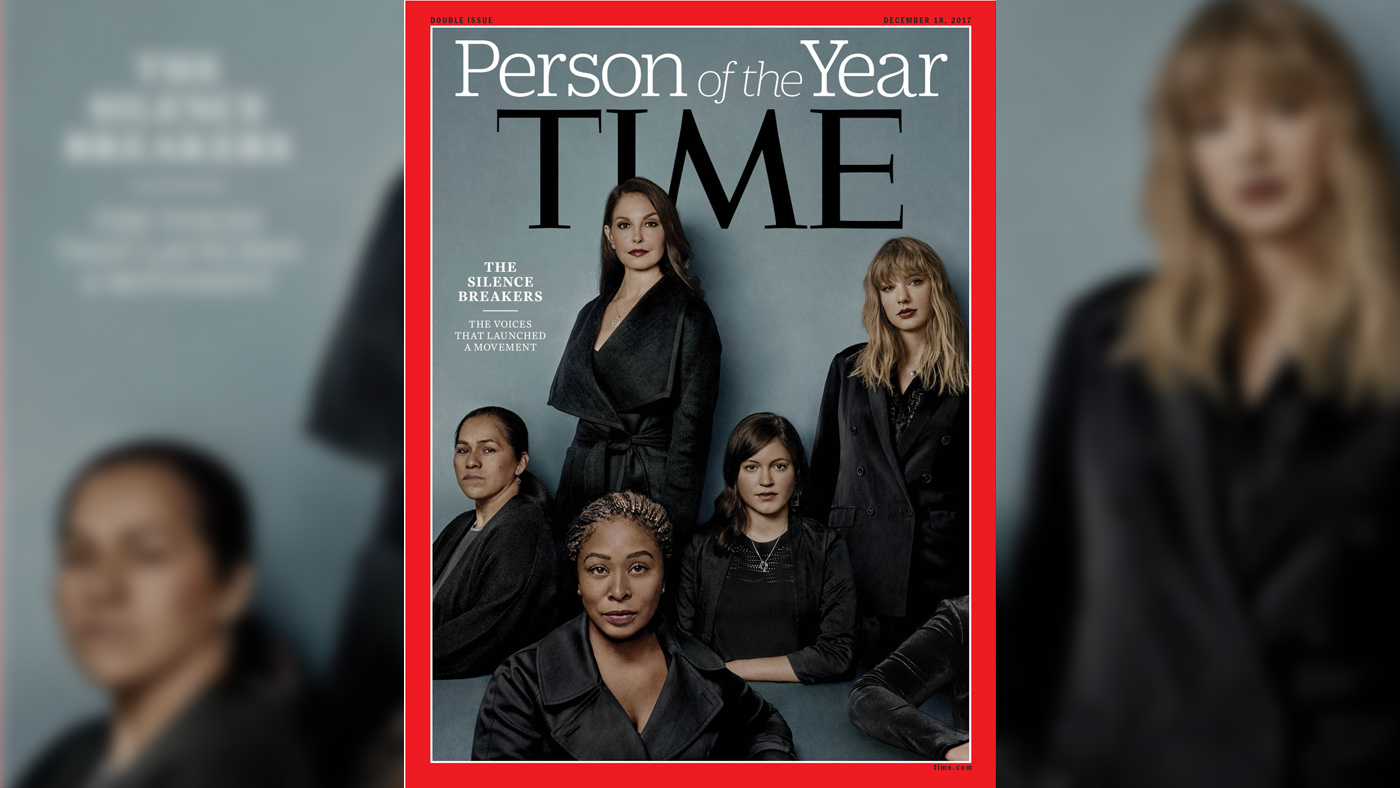Every year, Time Magazine chooses the person or people “who had the greatest influence, for better or worse, on the events of the year”—and every year, the winner is a big name or a popular story, overshadowing a weighty shortlist of more qualified runners-up, but not this year. The Silence Breakers, the men and women who spoke up to condemn sexual harassers and support victims everywhere, were granted the title of Person of the Year.
After weeks of trepidation, the announcement was a relief, and the accompanying article put a much-needed hopeful twist on the despair of seeing countless people posting #MeToo across social media throughout the year. But was the 2017 Person of the Year as much of a victory as it seems on the surface?
[su_youtube url=”https://www.youtube.com/watch?v=MkR8GY2YBAU”]
In short, no. By placing Donald Trump, a pussy-grabbing misogynist with sixteen allegations of sexual assault against him, at the top of this year’s shortlist, Time has made their priorities clear: not to publicize those who are fighting against social injustice in the U.S., but to sell copies and cause conversations, whether or not those conversations are potentially divisive or harmful to an already chaotic country.
The pattern of Time choosing a person who has made headlines all year and will grab attention on a front cover is not new. In 2016, Donald Trump was given the honor, while the CRISPR Pioneers, scientists who worked to use genetic engineering to combat cancer, were pushed onto the shortlist along with Beyoncé, whose album “Lemonade” became a political statement, powerful in its declaration of black pride and “feminist blackness.”
Time named Angela Merkel the 2015 Person of the Year, but the shortlist included Black Lives Matter and Caitlyn Jenner, both important and influential figures in 2015—perhaps Time feared that giving either of them the highest honor would cause uproar among opponents of their respective causes. Angela Merkel was a safer bet: a political leader, a big name, loved by some and hated by others—but either way, she was distanced from the U.S. both physically and ideologically, an unlikely figure to cause much widespread grumbling.
Time’s refusal to give 2015’s activists the recognition they deserved shrinks in importance beside the other names on the shortlist: Donald Trump (again) and Abu Bakr al-Baghdadi, the leader of ISIS. Why give a xenophobic, Islamophobic, sexist, racist, homophobic and transphobic sexual harasser the honor of being considered Person of the Year, not to mention bestowing the same honor upon a notorious terrorist? Even if Time claims the people they choose could have had a positive or negative impact on the events of the year, the title of Person of the Year has positive connotations that should not be associated with such horrible people.
This pattern of choosing a mind-boggling mix of good and bad people for the shortlist stretches a few years into the recent past. In 2014, the Ebola Fighters won, but the shortlist included the Ferguson Protestors and Vladimir Putin. In 2013, Pope Francis won, with LGBT activist Edith Windsor, Bashar Assad and Ted Cruz gracing the shortlist.
The pattern continued this year, with a shortlist including Colin Kaepernick and Patty Jenkins, but Donald Trump and Kin Jong Un as well. Time seems to have a habit of building their shortlist from a selection of a couple of people who had a negative impact on the year’s events, and a couple of people or groups fighting for equality in some way. But from that list, they choose a big name—the person who was most talked about throughout the year, but not the person most important to talk about.
On the subject of big names taking priority over more important ones, there was some well-deserved controversy about Taylor Swift’s inclusion on the cover of the 2017 issue. Swift’s triumphant lawsuit against a man who groped her lands her among the most talked about of the Silence Breakers—and that is exactly why Time put her on the cover, along with actress Ashley Judd, the first to expose Harvey Weinstein as a sexual harasser. They are recognizable faces that would pique a passerby’s interest and prompt them to flip through a copy of the magazine.
But what about Tarana Burke? She originated #MeToo ten years ago, before hashtags even existed, and has been fighting for victims of sexual assault for years. She was rightfully one of the Silence Breakers, and Time interviewed her, but her absence from the cover of the issue has raised eyebrows from those knowledgeable about her long-standing fight for justice.
What rankles Molly Roberts, the writer of a Washington Post article questioning whether Swift deserves her place on the cover, is that it seems Swift was part of the article more for PR than to fight for the Silence Breakers’ cause. Roberts takes issue with Swift’s stubborn silence on Trump, a sexual harasser himself, and her refusal to embrace the label of Silence Breaker once it no longer benefitted her directly; it seems to Roberts that Swift is “most willing to be outspoken when it benefits her brand,” and that she earned her place on the cover through her fame as an artist, not as an activist.
So once again, even after finally recognizing a group of people fighting for equality as Person of the Year instead of tucking them away on the shortlist, Time places their focus on what will sell rather than what will do good. And I get it, Time is a large magazine and it needs to attract attention and make money. But for once, it would be lovely if credit were given where it is due: to Burke, not Swift, and to good people, not Trump or other negative influencers.
Swift’s place on the cover and Trump’s place either as the winner or a runner-up three years in a row speaks to the same problem: the prioritization of moneymakers over change-makers. If Time thought it was so important in 2017 to honor the people who broke their silence to come out against sexual harassers, why did they nearly choose one of the most notorious of those harassers for the third year in a row? The Silence Breakers seems like a step in the right direction, but considering the names on the shortlist, it’s not enough.
The Person of the Year should always be someone whose cause needs publicity, not someone who caused a negative stir throughout the year—we need positivity and hope, not a rehashing of everything that already caused so much hopelessness all year. The Silence Breakers shattered Time’s recent tradition of choosing popular stories or controversial people for Person of the Year, but there is still much to do and far to go.
The fight for true change isn’t over yet, but if we strive to recognize more and more people who are fighting to improve the lives of millions, who are breaking their silence and shouting above the chaos to make their voices heard, we can establish the importance of positive change-makers and grow to become a society where saying that no one should be victimized is not a radical statement.
















